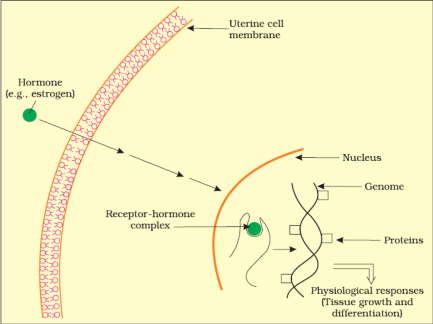Chemical Coordination - Revision Notes
CBSE Quick Revision Notes
CBSE Class-11 Biology
CHAPTER-22
CHEMICAL COORDINATION AND INTEGRATION
In animals, control and coordination is performed by neural system and endocrine system jointly. As the nerve fibres do not innervate all cells of the body, the endocrine system is required to coordinate the functions.
Endocrine Glands
- Endocrine glands are ductless glands. They release their secretion directly into blood which is then transported to specific target organs to initiate a particular metabolic change.
- The endocrine glands secrete chemicals called hormones.
- Hormones are non-nutrient chemicals which act as intercellular messengers and are produced in trace amount.
Human Endocrine System
The endocrine glands and hormone producing tissues/cells are located in different parts of the body. Gastrointestinal tract, kidney, liver and heart also produce small quantity of hormones to control and coordinate the function of respective organs.
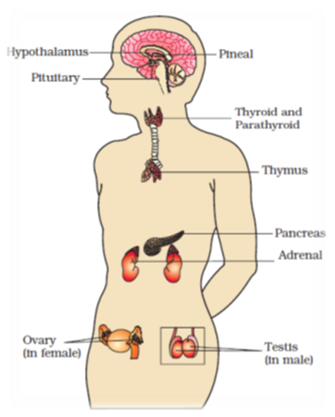
Hypothalamus contains several groups of neurosecretory cells called nuclei which produce hormones. Hormones released by Hypothalamus regulate the synthesis and secretion of pituitary hormones.
Hypothalamus produces two types of Hormones:

- The hormones released from hypothalamus reaches the anterior pituitary through portal circulatory system and regulate its function.
- The posterior pituitary is under direct control of hypothalamus.
Pituitary Gland is located in sella tursica, a bony cavity. It is attached to the hypothalamus by a stalk.
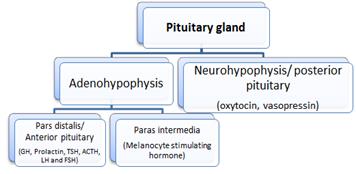
- Excess secretion of Growth Hormone causes over growth of the body leading to gigantism and low secretion causes stunted growth called dwarfism.
- Prolactin stimulates growth of mammary gland and production of milk.
- TSH stimulates production and release of thyroid hormone.
- LH and FSH stimulate activity of the gonads. In male, LH stimulates synthesis and secretion of androgen hormone from testis. In female, LH induces ovulation of fully mature ovum from ovary.
- Oxytocin helps in contraction of uterus during child birth and milk ejection from mammary glands.
- Vasopressin stimulates absorption of water and electrolyte in kidney.
- MSH acts on the melanocytes and regulates skin pigmentation.
The pineal Gland- located on dorsal side of forebrain and release melatonin hormone that helps to regulate diurnal rhythm of body like sleeps wake cycle and body temperature.
Thyroid Gland- composed of two lobes on either side of trachea connected by isthmus.
Thyroid gland is made of follicles and stromal tissues:
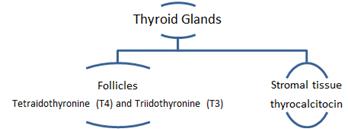
- Iodine is essential for synthesis of thyroid hormones. Deficiency of iodine leads to hypothyroidism (Goitre). During pregnancy, hypothyroidism may cause stunted growth of baby and mental retardation.
- Thyroid hormones regulate the basal metabolic rate. They support the process of red blood cell formation. They control the metabolism of carbohydrates, proteins and fats. Thyrocalcitonin hormone regulates blood calcium levels.
Parathyroid Gland- located on the back side of thyroid gland, secretes peptide hormone called parathyroid hormone (PTH). PTH regulates the calcium ion concentration in the blood. It also helps in reabsorption of calcium from renal tubules and digestive tracts.
Thymus- located on the dorsal side of heart and the aorta. This gland releases peptide hormone thymosins that help in differentiation of T-Lymphocytes for cell-mediated immunity. It also promotes production of antibodies to provide humeral immunity.
Adrenal Gland – located on anterior part of each kidney, composed of two types of tissues central adrenal medulla and outside adrenal cortex. Adrenal medulla secretes adrenaline and noradrenaline hormone commonly called as catecholamines. These hormones are also called as emergency hormone. These hormones increase alertness, pupilary dilation, sweating, heart beat, rate of respiration, glycogenolysis.
The adrenal cortex secretes glucocorticoids and mineralocorticoids. Glucocorticoids stimulate gluconeogenesis. Mineralocorticoids regulate water and electrolyte contents of the body.
Pancreas – acts as both endocrine and exocrine gland. Endocrine pancreas consists of “Islets of Langerhans” which contain α-cells and β-cells. The α-cells secrete hormone glucagon and β-cells secrete insulin. Both hormones are involved in maintenance of blood sugar levels.
- Glucagon is a peptide hormone that stimulates glycogenolysis resulting in increased blood sugar (hyperglycemia).
- Insulin is a peptide hormone that play major role in regulation of glucose homeostasis. It triggers rapid movement of glucose from blood to hepatocytes and adipocytes resulting in decreased blood glucose levels (hypoglycemia).
Testis – perform dual functions as a primary sex organ as well as endocrine glands. Leydig cells or interstitial cells produce androgen mainly testosterone which regulate maturation of primary sex organs and spermatogenesis.
Ovary – produce two groups of steroid hormones called estrogen and progesterone. Estrogen is synthesized and secreted by growing ovarian follicles. After ovulation, ruptured ovum called corpus luteum, secretes progesterone. Estrogen produces wide range actions like growth of female secondary sex organs, development of growing ovarian follicles, and regulation of female sexual behaviour.
Progesterone regulates pregnancy.
Hormones of Heart, Kidney and Gastrointestinal Tract
- Atrial wall of heart secretes peptide hormone called atrial natriuretic factor (ANF) which decreases blood pressure.
- The juxtaglomerular cells of kidney produce erythropoietin hormone which stimulate erythropoiesis.
- Gastro-intestinal tract secrete four major peptide hormones:
1. Gastrin stimulates the secretion of hydrochloric acid and pepsinogen.
2. Secretin acts on the exocrine pancreas and stimulates secretion of water and bicarbonate ions.
3. Cholecystokinin (CCK) stimulates the secretion of pancreatic enzymes and bile juice
4.Gastric inhibitory peptide (GIP) inhibits gastric secretion and motility.
Mechanism of Hormone Action
- Hormone produce their effects on target tissues by binding to specific protein called hormone receptors located in the target tissue.
- Binding of hormones to receptor leads to the formation of hormone receptor complex. This binding leads to change in target tissue.
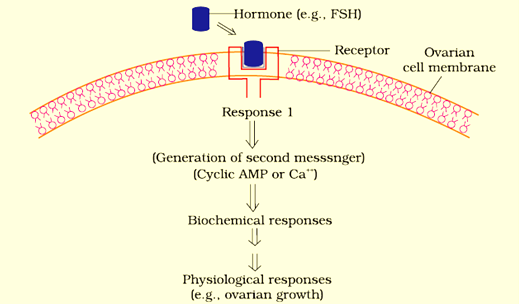
On the basis of chemical nature, hormones are grouped as-
- Peptide, polypeptide and protein hormones- insulin, glucagon, pituitary hormone, hypothalamic hormones.
- Steroids- cortisol, testosterone, progesterone.
- Idothyronines- thyroid hormones.
- Amino acid derivatives- epinephrine.
The hormones that bind with membrane bound receptors normally do not enter the target cells but generate second messenger which in turn regulate cellular metabolism.
The hormones (steroid hormones) which interact with intracellular receptors mostly regulate gene expression or chromosome function by interaction with hormone-receptor complex with the genome. These biochemical actions results in physiological and developmental effects.
